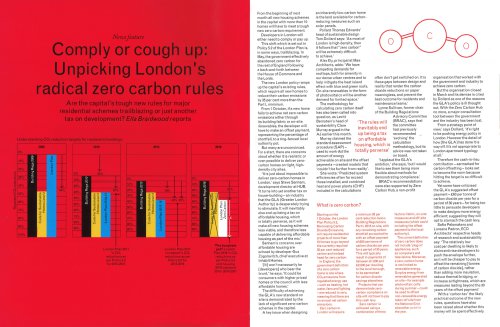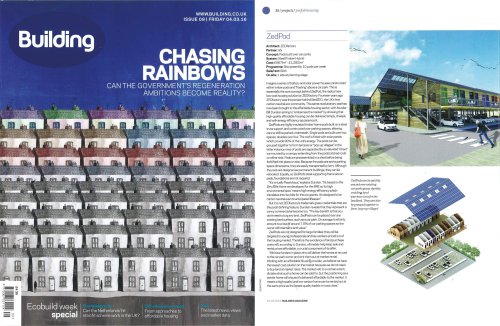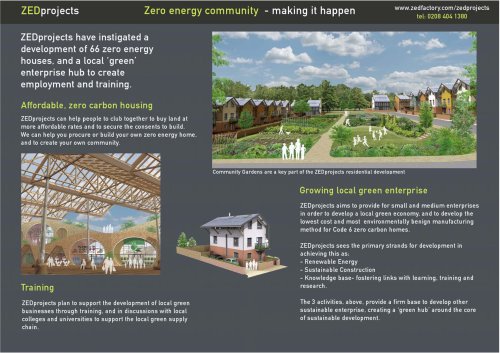
Catalog excerpts

Comply or cough up: Unpicking London's radical zero carbon rules Are the capital's tough new rules for major residential schemes trailblazing or just another tax on development? Ella Braidwood reports often don't get switched on. It is these gaps between design and reality that render the carbon dioxide reductions on paper meaningless, and prevent the best outcome for residents and maintenance teams.’ Lynne Sullivan, former chair of the Building Regulations Advisory Committee (BRAC), says that the committee had previously recommended ‘evolving’the housing, which is "™gy, but its totally perverse advice was not taken on board. 'I applaud the GLA’s ambition,' she says, ‘but I would like to see them being more flexible about methods for demonstrating compliance.' BRAC's recommendations were also supported by Zero Carbon Hub, a non-profit ‘The rules will inevitably end up being a tax on affordable a minimum 35 per cent reduction below Building Regulations Part L 2013 on site, with any remaining carbon shortfall accounted for with an offset payment of £60 per tonne of carbon dioxide per year for a period of 30 years. This will typically result in payments of between £1,000 and £2,000 per dwelling to the local borough, to be earmarked for carbon dioxide savings elsewhere. Projects that can demonstrate zero-carbon compliance on site will not have to pay this cash levy. 'Zero carbon’ is achieved using a combination of three factors: fabric, on-site measures and off-site measures (which could including the offset payment to the local authority). The current definition of zero carbon does not include 'plug-in' appliances, such as computers and televisions. Moreover, a zero-carbon home is not limited to renewable energy. Surplus energy from renewables generated on site-for example photovoltaic cells during summer-could be used to offset non-renewable energy taken off site from the National Grid at another point in the year. From the beginning of next month all new housing schemes in the capital with more than 10 homes will have to meet a tough new zero carbon requirement. Developers in London will either need to comply or pay up. This shift which is set out in Policy 5.2 of the London Plan is, in some ways, trailblazing. In May, the government effectively abandoned zero carbon for the rest of England following a back-and-forth between the House of Commons and the Lords. The new London policy ramps up the capital’s existing rules, which require all new homes to reduce their carbon emissions by 35 per cent more than the Part L minimum. From 1 October, if a new home fails to achieve net zero carbon emissions either through its building fabric or on-site renewables, the developer will have to make an offset payment, representing the percentage of shortfall, to a ring-fenced local authority pot. But many are unconvinced. For a start, there are concerns about whether it is realistic or even possible to deliver zero-carbon homes on tight, high-density city sites. ‘It is just about impossible to deliver zero-carbon homes in London,’ says Steve Sanham, development director at HUB. ‘It turns into yet another tax on house-building-an industry that the GLA (Greater London Authority) is desperately trying to stimulate. It will inevitably also end up being a tax on affordable housing, which is totally perverse, as it will make all new housing schemes less viable, and therefore less capable of delivering affordable housing as part of the mix.’ Sanham’s concerns over affordable housing are echoed by developer Gus Zogolovitch, chief executive at Inhabit Homes. '[It] won't necessarily be [developers] who bear the brunt,’ he says. ’It could be consumers with higher priced homes or the council with less affordable homes.’ The difficulty of achieving the GLA’s new standard on site is demonstrated by the lack of significant zero-carbon schemes in the capital. A key issue when designing an inherently low-carbon home is the land available for carbon-reducing measures such as solar panels. Pollard Thomas Edwards’ head of sustainable design Tom Dollard says: ‘As most of London is high density, then it follows that “zero carbon" will be extremely difficult to achieve.’ Alex Ely, principal at Mae Architects, adds: ‘We have competing demands for rooftops, both for amenity in our dense urban centres and to help mitigate the heat island effect with blue and green roofs. On-site renewables in the form of photovoltaics will be another demand for limited space.' The methodology for calculating zero carbon itself has also been called into question, as Levitt Bernstein’s head of sustainbility Clare Murray argued in the AJ earlier this month. Murray claimed the standard assessment procedure (SAP) -used to work Olit the amount of energy achievable on site and the offset payments-created models that 'couldn’t be further from reality’. She wrote: ‘Predicted system efficiencies often far exceed those installed, and combined heat and power plants (CHP) included in the calculations Starting on the 1 October, the London Plan Policy 5.2, Minimising Carbon Dioxide Emissions, will require residential projects of more than 10 homes to go beyond the currently required 35 per cent reduced carbon and instead head for zero carbon. In England, the government definition of a zero carbon home is one where CO? emissions from regulated energy use -such as heating, hot water, fans and lighting -are reduced to zero, meaning that there are no annual net carbon emissions. Zero carbon in London will require organisation that worked with the government and industry to achieve zero carbon. But the organisation closed in March and its demise is cited by Dollard as one of the reasons the GLA's policy is ill thought out. With the Zero Carbon Hub no more, a major consultation tool between the government and the industry has been lost. 'From a strategy point of view,’ says Dollard, 'it's right to be pushing energy policy in London. However the detail of how [the GLA] has done it is way off. It’s not appropriate to London apartment typology at all.’ Therefore the cash-in-lieu contribution-earmarked for carbon offsetting - looks set to become the norm because hitting the target is so difficult to achieve. Yet some have criticised the GLA’s suggested offset payment - £60 per tonne of carbon dioxide per year for a period of 30 years - for being too little to persuade developers to make designs more energy efficient; suggesting they will opt to stomach the cash levy. Sofie Pelsmakersand Loreana Padron, ECD Architects' respective heads of research and sustainability say: 'The relatively low cost per dwelling is likely to disincentivise developers to push the envelope further, as it will be cheaper to pay to offset the remaining [tonnes of carbon dioxide], rather than adding more insulation, reduce thermal bridging, or increase airtightness, which are measures lasting beyond the 30 years of the offset payment.' With a 'carbon tax’ the likely practical outcome of the new rules, questions have also been raised about whether t
Open the catalog to page 1All ZEDfactory catalogs and technical brochures
-
From A to ZED
4 Pages
-
ZEDpods-'pop-up villages'
1 Pages
-
ZED transport
6 Pages
-
Zero Energy Community
2 Pages





